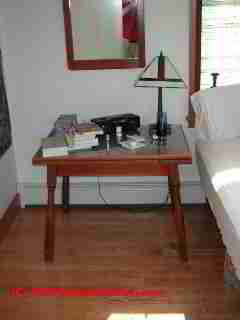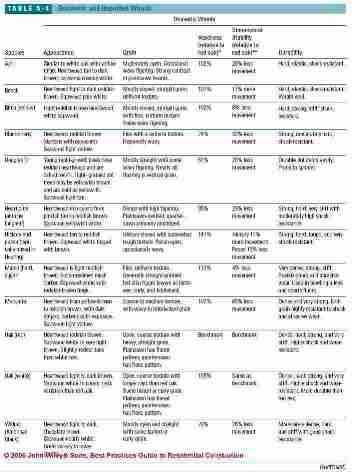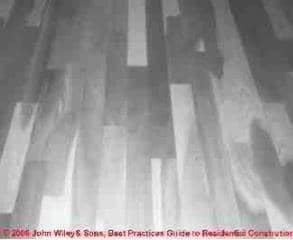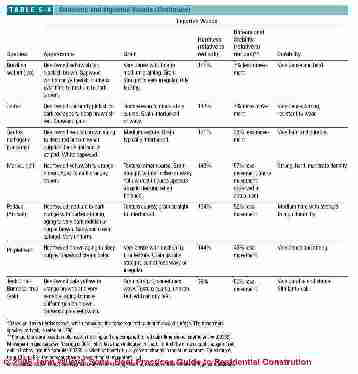 Best Practices Guide to Solid Wood Floors
Best Practices Guide to Solid Wood Floors
Strip Flooring & Plank Flooring Installation
- POST a QUESTION or COMMENT about how to buy, install, troubleshoot, or repair solid wood flooring
Solid wood flooring choices & installation:
This article contains details on the best methods for installing solid strip or plank wood flooring.
This article series discusses and provides a best construction practices guide to the selection and installation of building interior surface materials, carpeting, doors, drywall, trim, flooring, lighting, plaster, materials, finishes, and sound control materials.
InspectAPedia tolerates no conflicts of interest. We have no relationship with advertisers, products, or services discussed at this website.
- Daniel Friedman, Publisher/Editor/Author - See WHO ARE WE?
Guide to Selecting & Installing Wood Floors: Best Practices
 As described in the book, Best Practices Guide to Residential Construction (Steve Bliss, J Wiley & Sons) Chapter 5, Interior Finish:
As described in the book, Best Practices Guide to Residential Construction (Steve Bliss, J Wiley & Sons) Chapter 5, Interior Finish:
Wood floors provide a natural warmth and beauty like no other flooring material. And new developments in finishes and engineered products have expanded their durability, versatility, and ease of installation.
Still, control of moisture levels in the flooring and structure around it remains the biggest issue influencing the success of a wood flooring installation, particularly with unfinished strip flooring, but with many of the engineered products as well.
[Click any table or figure to see an enlarged, detailed version.]
Solid Wood Strip and Plank Wood Floor Choices
Traditional unfinished 3 /4-inch hardwood strip flooring in oak or maple remains the most common wood flooring type and the best choice where heavy use and frequent refinishing are likely.
While the most common species are still oak and maple, an amazing variety of domestic and imported woods have become available in recent years.
Wood Species Choices & Properties for Wood Flooring
Flooring species are rated for hardness and dimensional stability (see Table 5-4 and its continuation Table 5-4b provided just below). Wood Hardness is rated on the Janka scale, which measures the force required to push a small steel ball into the wood surface.
The results are often compared to red oak, which is used as a benchmark. Unless a floor with lots of “character” caused by dents and wear marks is desired, avoid woods significantly softer than oak.
Also consider the wood’s dimensional stability. Less stable woods are likely to lead to gaps, cupping, or other problems with wider plank flooring and in regions like the Northeast, which has big seasonal swings in relative humidity.
Other locations where moisture movement might be a problem include below-grade spaces, slabs-on-grade without vapor barriers, or rooms over crawlspaces. In these environments, choose a stable wood and a narrow profile to avoid problems.
Laminated floors, discussed below, are often the best choice for these applications.
A number of exotic hardwood imports are also now available. Many of these are plantation-raised or logged with sustainable forestry practices, but some are not. To be sure, work with a reputable importer and look for third party certification of sustainable logging practices.
For more information, contact the Forest Stewardship Council or the Smartwood program (see Buy Interior Finish Product Resources).
Hardwood vs. Softwood Options for Wood Floors
While hardwoods are harder and more durable than softwoods in general, this is not always the case.
For example, heart-pine flooring, whether antique or new (cut from the centers of longleaf southern yellow pines) is nearly as hard as oak, while black cherry, a popular hardwood flooring, is 26% softer than oak.
Other traditional softwood choices are white pine, popular for Colonial reproductions in the Northeast, and fir flooring in the Northwest. While fir flooring is dimensionally stable, wide white pine boards can be expected to swell and shrink significantly, leaving gaps in the winter months.
Both are relatively soft and easy to dent, creating a rustic appearance.
Strip vs. Plank Options for Wood Floors
Narrow flooring boards up to 3 1/4-inches wide are called strips and boards 4 inches and wider are called planks. The wider the board, the greater the seasonal movement will be and the fewer the number of fasteners to resist movement.
Plank flooring over 4 or 5 inches wide has a greater tendency to shrink and leave gaps, or to swell, causing the flooring to cup or curl over time. For that reason, some manufacturers recommend additional fasteners in the face of plank flooring, either nails or countersunk screws.
Also the wider the board, the more critical
it is to monitor and control moisture conditions of the
flooring and structure.
See FLOOR, WOOD MOISTURE).
Solid Wood Flooring Grades & Properties
 The best grades of wood flooring have longer
pieces, fewer variations in color (more heartwood), and
fewer knots and other defects.
The best grades of wood flooring have longer
pieces, fewer variations in color (more heartwood), and
fewer knots and other defects.
Quartersawn grades will have much better dimensional stability, with 30 to 50% less movement than plainsawn boards.
In better solid wood flooring grades, pieces are also likely to be straighter,
making life easier for the installer.
With many species, however, the visual variations in lower grades can be attractive as well as economical.
A No. 2 or No. 3 maple or cherry floor can be distinctive and striking (Figure 5-5).
-- Adapted with permission from Best Practices Guide to Residential Construction (Steve Bliss, J Wiley & Sons) .
Prefinished Wood Flooring Manufacturers & Sources
- Alloc Inc. www.alloc.com Snap-together, no-glue long-strip and single-strip laminated flooring
- Anderson Hardwood Floors www.andersonfloors.com Laminated strip, nail, glue, and floating
- Armstrong World Industries www.armstrong.com Bruce, Hartco, and Robbins prefinished plank and engineered strip
- BHK of America www.bhkuniclic.com Snap-together, no-glue laminated wood flooring
- Columbia Wood Flooring www.columbiaflooring.com Prefinished solid strip
- Duro-Design www.duro-design.com Floating click-lock oak flooring
- Gammapar www.gammapar.com Engineered wood strip with oil, UV-cured urethane, or acrylic-impregnated finish
- Junkers Hardwood www.junkershardwood.com Floating solid strip with metal clip installation
- Kahrs www.kahrs.com Laminated strip with UV-cured acrylic urethane, nail, glue, or floating
- Lauzon www.lauzonltd.com Prefinished strip, laminated strip, and click-lock laminated plank
- Mannington Mills www.mannington.com Laminated strip and plank with polyurethane and aluminum-oxide finish
- Medallion Hardwood Flooring www.medallionhardwood.com Prefinished solid hardwood strip and plank with aluminum-oxide finish
- Tarkett Wood Floors www.harris-tarkett.com Prefinished solid hardwood, laminated, and long-strip flooring
- MercierWood Flooring www.mercierdurable.com Prefinished solid strip and laminated strip with aluminum-oxide finish
- PermaGrain Hardwood Flooring www.permagrain.com Acrylic-impregnated laminated strip and plank
- Zickgraf Hardwood Flooring www.zickgraf.com Prefinished solid strip with UV-cured urethane with diamond and aluminum oxide
Bamboo Flooring Producers & Sources
- Details are at BAMBOO FLOORING
- Bamtex (a division of Wood Flooring International) www.bamtex.com Laminated bamboo and palm flooring
- Duro-Design www.duro-design.com Laminated bamboo flooring with durable water-based finish
- Gammapar www.gammapar.com Acrylic-impregnated bamboo flooring
- Hawa Bamboo Flooring www.hawabamboo.com Prefinished bamboo flooring with aluminum-oxide finish
- Natural Cork www.naturalcork.com Prefinished glue-down or nail-down 3-ply bamboo planks with aluminum-oxide finish
Cork Flooring Manufacturers & Sources
- American Cork Products Co. www.amcork.com Prefinished parquet tiles and floating floor planks
- Amorim Revestimentos (formerly Ipocork) www.wicanders.com Floating or glue-down laminated cork tiles with UV-acrylic or oil finish
- BHK of America www.bhkuniclic.com Snap-together, no-glue, laminated cork flooring with UV-acrylic finish
- Expanko Cork Inc. www.expanko.com Cork tiles with wax or polyurethane finish
- Korq Inc. (212) 758-2593
- Natural Cork www.naturalcork.com Glue-down cork tiles and floating laminated planks with UV-cured acrylic finish
- Nova Distinctive Floors www.novafloorings.com Laminated cork planks with glue-down and floating click-lock installation
- WECork www.wecork.com Cork tiles, sheets, and floating floors
Industry & Trade Associations for Flooring and Floor Products
- Carpet and Rug Institute (CRI) www.carpet-rug.org
- Forest Stewardship Program www.fscus.org
- FloorFacts www.floorfacts.com
- National Oak Flooring Manufacturers Association (NOFMA) www.nofma.com
- National Wood Flooring Association www.woodfloors.org
- Smartwood/Rainforest Alliance www.smartwood.org
-- Adapted with permission from Best Practices Guide to Residential Construction (Steve Bliss, J Wiley & Sons) .
...
Continue reading at FLOOR, WOOD TYPES or select a topic from the closely-related articles below, or see the complete ARTICLE INDEX.
Or see
Suggested citation for this web page
FLOOR, WOOD SOLID STRIP, PLANK at InspectApedia.com - online encyclopedia of building & environmental inspection, testing, diagnosis, repair, & problem prevention advice.
Or see this
INDEX to RELATED ARTICLES: ARTICLE INDEX to BUILDING FLOORING
Or use the SEARCH BOX found below to Ask a Question or Search InspectApedia
Or see
INDEX to RELATED ARTICLES: ARTICLE INDEX to BUILDING INTERIORS
Or use the SEARCH BOX found below to Ask a Question or Search InspectApedia
Ask a Question or Search InspectApedia
Try the search box just below, or if you prefer, post a question or comment in the Comments box below and we will respond promptly.
Search the InspectApedia website
Note: appearance of your Comment below may be delayed: if your comment contains an image, photograph, web link, or text that looks to the software as if it might be a web link, your posting will appear after it has been approved by a moderator. Apologies for the delay.
Only one image can be added per comment but you can post as many comments, and therefore images, as you like.
You will not receive a notification when a response to your question has been posted.
Please bookmark this page to make it easy for you to check back for our response.
IF above you see "Comment Form is loading comments..." then COMMENT BOX - countable.ca / bawkbox.com IS NOT WORKING.
In any case you are welcome to send an email directly to us at InspectApedia.com at editor@inspectApedia.com
We'll reply to you directly. Please help us help you by noting, in your email, the URL of the InspectApedia page where you wanted to comment.
Citations & References
In addition to any citations in the article above, a full list is available on request.
- Steve Bliss's Building Advisor at buildingadvisor.com helps homeowners & contractors plan & complete successful building & remodeling projects: buying land, site work, building design, cost estimating, materials & components, & project management through complete construction. Email: info@buildingadvisor.com
Steven Bliss served as editorial director and co-publisher of The Journal of Light Construction for 16 years and previously as building technology editor for Progressive Builder and Solar Age magazines. He worked in the building trades as a carpenter and design/build contractor for more than ten years and holds a masters degree from the Harvard Graduate School of Education. Excerpts from his recent book, Best Practices Guide to Residential Construction, Wiley (November 18, 2005) ISBN-10: 0471648361, ISBN-13: 978-0471648369, appear throughout this website, with permission and courtesy of Wiley & Sons. Best Practices Guide is available from the publisher, J. Wiley & Sons, and also at Amazon.com - Our recommended books about building & mechanical systems design, inspection, problem diagnosis, and repair, and about indoor environment and IAQ testing, diagnosis, and cleanup are at the InspectAPedia Bookstore. Also see our Book Reviews - InspectAPedia.
- In addition to citations & references found in this article, see the research citations given at the end of the related articles found at our suggested
CONTINUE READING or RECOMMENDED ARTICLES.
- Carson, Dunlop & Associates Ltd., 120 Carlton Street Suite 407, Toronto ON M5A 4K2. Tel: (416) 964-9415 1-800-268-7070 Email: info@carsondunlop.com. Alan Carson is a past president of ASHI, the American Society of Home Inspectors.
Thanks to Alan Carson and Bob Dunlop, for permission for InspectAPedia to use text excerpts from The HOME REFERENCE BOOK - the Encyclopedia of Homes and to use illustrations from The ILLUSTRATED HOME .
Carson Dunlop Associates provides extensive home inspection education and report writing material. In gratitude we provide links to tsome Carson Dunlop Associates products and services.


